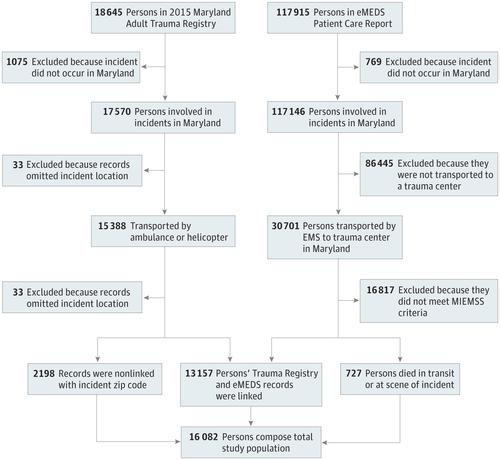JAMA Surgery ( IF 15.7 ) Pub Date : 2018-06-01 , DOI: 10.1001/jamasurg.2017.6133 Molly P. Jarman 1, 2 , Frank C. Curriero 3 , Elliott R. Haut 4 , Keshia Pollack Porter 2 , Renan C. Castillo 2

|
Importance Rural, low-income, and historically underrepresented minority communities face substantial barriers to trauma care and experience high injury incidence and mortality rates. Characteristics of injury incident locations may contribute to poor injury outcomes.
Objective To examine the association of injury scene characteristics with injury mortality.
Design, Setting, and Participants In this cross-sectional study, data from trauma center and emergency medical services provided by emergency medical services companies and designated trauma centers in the state of Maryland from January 1, 2015, to December 31, 2015, were geocoded by injury incident locations and linked with injury scene characteristics. Participants included adults who experienced traumatic injury in Maryland and were transported to a designated trauma center or died while in emergency medical services care at the incident scene or in transit.
Exposures The primary exposures of interest were geographic characteristics of injury incident locations, including distance to the nearest trauma center, designation level and ownership status of the nearest trauma center, and land use, as well as community-level characteristics such as median age and per capita income.
Main Outcomes and Measures Odds of death were estimated with multilevel logistic regression, controlling for individual demographic measures and measures of injury and health.
Results Of the 16 082 patients included in this study, 8716 (52.4%) were white, and 5838 (36.3%) were African American. Most patients were male (10 582; 65.8%) and younger than 65 years (12 383; 77.0%). Odds of death increased by 8.0% for every 5-mile increase in distance to the nearest trauma center (OR, 1.08; 95% CI, 1.01-1.15; P = .03). Compared with privately owned level 1 or 2 centers, odds of death increased by 49.9% when the nearest trauma center was level 3 (OR, 1.50; 95% CI, 1.06-2.11; P = .02), and by 80.7% when the nearest trauma center was publicly owned (OR, 1.81; 95% CI, 1.39-2.34; P < .001). At the zip code tabulation area level, odds of death increased by 16.0% for every 5-year increase in median age (OR, 1.16; 95% CI, 1.03-1.30; P = .02), and decreased by 26.6% when the per capita income was greater than $25 000 (OR, 0.73; 95% CI, 0.54-0.99; P = .05).
Conclusions and Relevance Injury scene characteristics are associated with injury mortality. Odds of death are highest for patients injured in communities with higher median age or lower per capita income and at locations farthest from level 1 or 2 trauma centers.
中文翻译:

创伤护理距离,社区收入和邻里中位年龄与伤害死亡率的相关性
重要性 农村,低收入和历史上代表性不足的少数民族社区在创伤护理方面面临着实质性障碍,受伤率高且死亡率高。伤害事故发生地点的特征可能会导致较差的伤害结果。
目的 探讨损伤现场特征与损伤死亡率之间的关系。
设计,设置和参与者 在本横断面研究中,对由紧急医疗服务公司和马里兰州指定的创伤中心从2015年1月1日至2015年12月31日提供的创伤中心和紧急医疗服务的数据进行了地理编码通过伤害事故的发生地点,并与伤害现场特征联系在一起。参加者包括在马里兰州遭受外伤的成年人,这些成年人被运送到指定的创伤中心或在事故现场或在途中接受紧急医疗服务时死亡。
暴露 主要关注的暴露是伤害事故发生地点的地理特征,包括到最近的创伤中心的距离,最近的创伤中心的指定级别和所有权状态,土地使用以及社区级别的特征,例如中位数年龄和人均人均收入。
主要结果和措施 死亡几率通过多因素Logistic回归估算,控制个人人口统计学指标以及伤害和健康指标。
结果 纳入本研究的16082名患者中,白人为8716名(52.4%),非裔美国人为5838名(36.3%)。大多数患者为男性(10 582; 65.8%),且年龄小于65岁(12 383; 77.0%)。到最近的创伤中心的距离每增加5英里,死亡几率就会增加8.0%(OR为1.08; 95%CI为1.01-1.15;P = .03)。与私有的1级或2级中心相比,最近的创伤中心为3级时(OR,1.50; 95%CI,1.06-2.11;P = .02),死亡几率增加了49.9%,而在1级或2级创伤中心,则增加了80.7%。最近的创伤中心是公共所有的(OR为1.81; 95%CI为1.39-2.34;P <.001)。在邮政编码列表区域一级,中位数年龄每增加5年,死亡几率增加16.0%(OR为1.16; 95%CI为1.03-1.30;P = .02),当人均收入超过$ 25 000(OR,0.73; 95%CI,0.54-0.99;P = .05)时,下降了26.6%。
结论和相关性 受伤现场特征与伤害死亡率相关。在中位年龄较高或人均收入较低且距第一或第二级创伤中心最远的社区中受伤的患者的死亡几率最高。









































 京公网安备 11010802027423号
京公网安备 11010802027423号